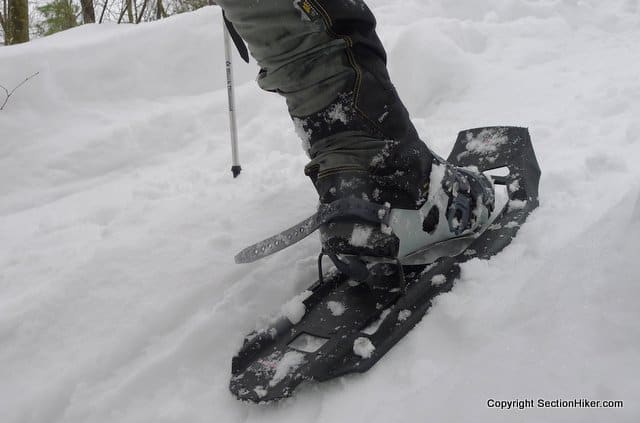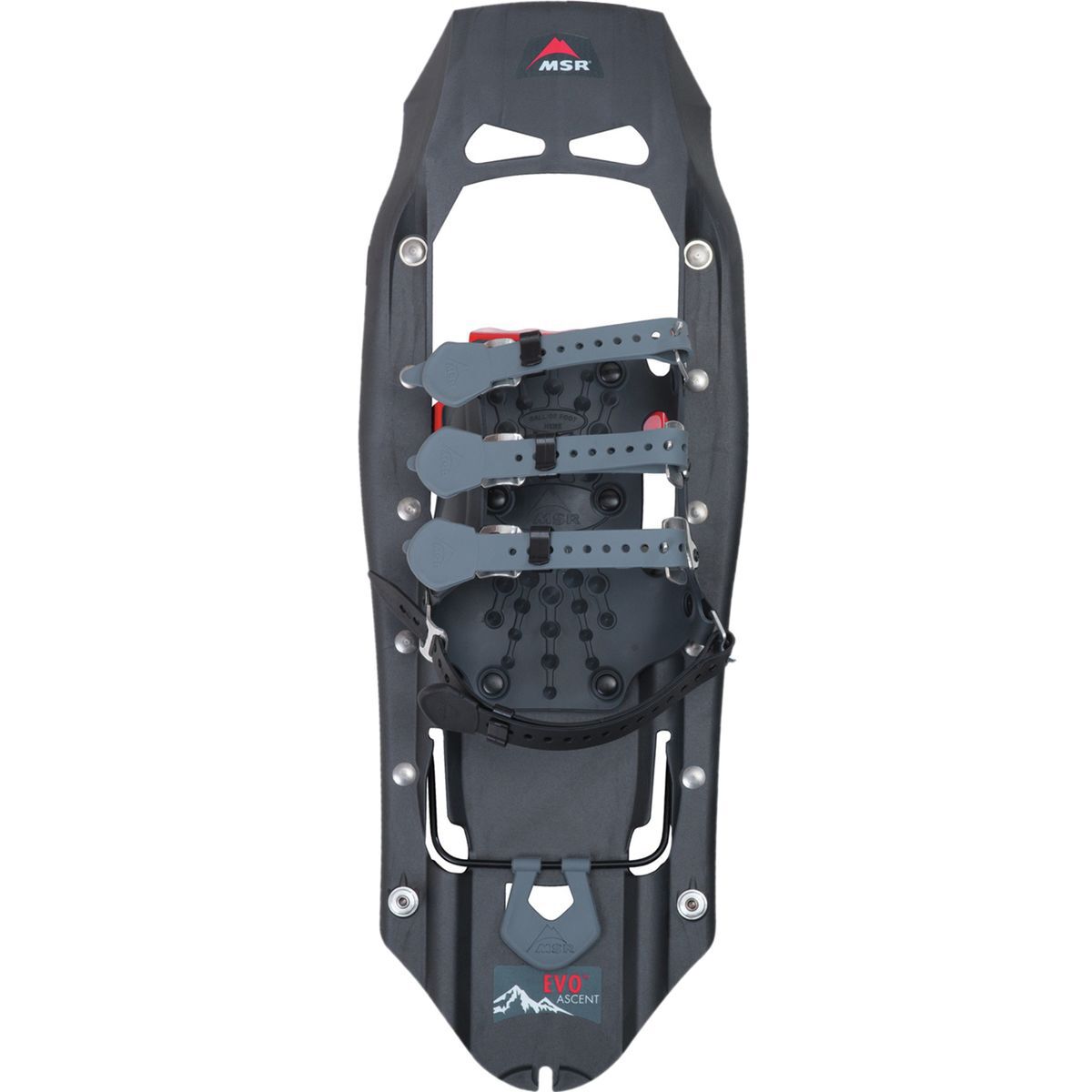
I started using a different pair of snowshoes a few years ago, switching from a pair of MSR Lightning Ascents to a pair of Evo Ascent Snowshoes, also from MSR. While the Lightning Ascents are great snowshoes for mountainous winter hiking and snowshoeing, I needed a more durable more maneuverable snowshoe for off-trail bushwhacking in dense vegetation.
MSR Evo Ascent Snowshoes
Weight
Durability
Binding
Traction
Flotation
Comfort
Don’t get me wrong, the MSR Lightning Ascent is a bomber snowshoe that excels on mountainous terrain and hiking trails and I plan to keep using my current pair for that purpose. But the off-trail nature of bushwhacking requires a very different set of capabilities from a snowshoe including unibody construction to avoid getting hung up on brush.
A Bushwhacking Primer
I dived into bushwhacking at the beginning of last winter and have continued doing it since. A four-season sport, it is slightly easier in winter because the leaves have fallen off the trees and the heavy forest understory is covered with snow.

While bushwhacking builds on all of your hiking skills, it is really hard on gear, puncturing, tearing, and scratching your clothes and equipment. It’s rare when I don’t come home from a bushwhack without shedding blood or ripping up some gear.
Snowshoes for Bushwhacking
When it comes to snowshoes for bushwhacking, less is more. Shorter length snowshoes are much more maneuverable through dense brush than long ones despite the fact that they provide less flotation in deep powder. Plus snowshoes with a smaller surface area are actually easier to pull out of deep powder than bigger ones. Further, climbing aids, like the MSR’s televator bails are even more important than normal because off-trail routes can be very steep, unlike graded hiking trails.
But the most important requirement for a bushwhacking snowshoe, besides being indestructible of course, is that it not catch on protruding branches when you’re battling through the brush. This requires a uni-body construction where the snowshoe frame and deck are molded from a single piece of material instead of the separate frame and riveted decking you commonly find on other snowshoes. It doesn’t take many face plants to figure this out. When bushwhacking through dense forest, little branches invariably get caught between the frame and decking and splat – down you tumble, into the snow, trapped until one of your hiking mates disentangles you.

As you can see above, there is no separate decking on the MSR Evo Ascent Snowshoe which is basically a big piece of plastic with aggressive size crampons riveted to the underside of the frame. The orientation of the crampons prevents snow from balling up under them. In addition, there are several horizontal plastic ribs on the underside of the snowshoe that also provide some traction but mainly act as brakes when coming down steep slopes with packed snow or in slushy conditions.

Lengthwise, the Evo Ascents come in one size, 22″ long, which I’ve always found a little frustrating because they’re a great snowshoe for regular trail hiking as well as bushwhacking. Still, if you need more flotation for deep powder, you can buy a pair of add-on flotation tails that attach to the rear of the snowshoe. My only caution with doing this is that the combination may be heavier than a standalone snowshoe that is sized appropriately for your needs, and I would avoid carrying a pair of flotation tails around unless you absolutely know you will need them.
All of the “Ascent Series” snowshoes in the MSR product line including the Evo Ascent and Lightning Ascent snowshoes have a piece of wire that you can flip up under the heel of your boot when climbing up hills. Called “Telvators”, they reduce the strain on your calves which causes lower leg fatigue making it much easier to climb steep trails while maintaining excellent contact between the crampons and the snow surface. I simply won’t buy snowshoes that don’t have this feature for New England hiking.

There’s a small plastic tab attached to the Televators on the Evo Ascents, that makes them easy to grab and lock into place under your heels. To lower them, I find that a sharp crack with the top of my trekking poles against the wire produces enough force to disengage them so I don’t have to bend down and do it.

Equally important for bushwhacking and mountaineering is the need to have a secure binding system that is compatible with many different sizes of footwear ranging from insulated winter boots and pac boots to bulky mountaineering boots. MSR’s binding system uses four plastic straps that lock your boot to the snowshoe and are easy enough to secure without taking off your gloves. Though not as fast as some other bindings, the plastic straps are completely waterproof and unaffected by cold temperatures.
The bindings also fold completely flat making them far easier to attach to your backpack and carry when not needed. That’s actually something I care about a lot about for bushwhacking because it lets me carry my snowshoes on the side of my pack, closer to my center of gravity, and helps reduces my profile when I’m bushwhacking off-trail.
Comparable Winter Hiking Snowshoes
| Make / Model | Heel Bar | Binding |
|---|---|---|
| MSR Lightning Ascent | Yes | Mesh Net |
| MSR Evo Ascent | Yes | TriFit Straps |
| Tubbs Flex VRT | Yes | Boa |
| Tubbs Flex ALP | Yes | Ratchet Strap |
| TSL Symbioz Elite | Yes | Ratchet Strap |
| Tubbs Mountaineers | Yes | Ratchet Strap |
| Atlas Range BC | Yes | Webbing Strap |
| MSR Revo Explore | Yes | Ratchet Strap |
| Northern Lites Backcountry | No | Ski Straps |
| Crescent Moon Backcountry 32 | Yes | Webbing Strap |
Recommendation
I have to confess, I didn’t discover the utility of using MSR Evo Ascent snowshoes for winter bushwhacking in New England on my own. Several of my off-trail mentors use these snowshoes and I decided to try them to see why they like them so much. Bushwhacking with them is so much easier and more efficient than larger snowshoes, that I am also convinced that they’re the right snowshoe for bushwhacking in New England.
Disclosure: Cascade Designs provided Philip Werner (SectionHiker.com) with a sample pair of MSR Evo Ascent snowshoes for this review.
Compare 3 Prices
-

 Backcountry.com
Backcountry.com$239.95$179.89View -

 Amazon USUsed $178.56$239.95View
Amazon USUsed $178.56$239.95ViewAmazon.com Price: $239.95 (as of 04/18/2024 22:06 GMT-0400) Details
Product prices and availability are accurate as of the date/time indicated and are subject to change. Any price and availability information displayed on Amazon.com at the time of purchase will apply to the purchase of this product.
-
 REI$239.95View
REI$239.95View
 SectionHiker.com Backpacking Gear Reviews and FAQs
SectionHiker.com Backpacking Gear Reviews and FAQs 
Thanks for the review!
The Evo Ascent seems to be an appealing all-around bomber for the rockier Whites (Washington, Lincoln / Liberty) with a few larger expeditions thrown in. However, the lack of a 25″ size is pushing me towards the lightning ascent. If you were looking for a one snowshoe quiver that will stand up to mixed rock/ice conditions AND for someone where a 25″ shoe makes the most sense; would you spring for the lightning ascent or the evo ascent?
The Lightning ascent is fine for rock and ice. I use the Evo ascent because it’s more convenient off-trail, since there’s no decking to catch in the trees. I use the 22″ size, just fine.
I’m trying to decide between the Lightning Ascent 22s and the Evo Ascent 22s for use in the Adirondacks – primarily trails. I think the terrain and weather conditions are similar enough to the Whites for comparison. After reading both your reviews I don’t see any true advantage to the Lightnings considering the much higher price point (beyond being quieter because of the softer material used). Any advice?
I would go with the lightning ascents for trails. They do have slightly better traction on slopes because they have metal cross pieces that act as crampons.
Thanks Philip!
I’ve had the same question as Anthony, for the Adirondacks as well. Did you feel that the increased traction was enough to justify the additional cost? Also, I’m really hoping to use one pair of shoes for hunting as well as trails, would you have a recommendation of one shoe over the other with the potential for dragging a heavy animal out of the woods?
I’d go with Evo Ascents for anything off trail. The space between the frame and the decking on lightning ascents catches branches frequently leading to annoying faceplants. The all plastic construction of the Evo Ascents avoids this. Size up if you’re plan to haul beasts out of the woods.
Thanks Philip! Also wanted to tell you how much I’ve enjoyed your other gear reviews. They’ve been a big help in transitioning from the heavy military gear I’ve been using for years.
How would this shoe fair as a thru hiking snowshoe for long trails like the cdt or the gdt? I’ve noticed that dan durston had the youth version of the evos (18″) for the gdt.
These are bomber. I’ve been using mine for close to 10 years, really hard.
Hi Philip,
I’m looking to upgrade to a better hiking Snowshoe. I’m considering both the MSR lightning ascent and the Evo. I do do some bushwhacking and I sometimes go alone having to breakout Trail on occasion. I was hoping to Simply buy one pair of snowshoes. Although I do do more Trail hiking than off Trail. Which would you suggest for an all-around hiking Snowshoe? As well as just going on local trails near home which are not mountainous.
I think either would be fine. The nice thing about the evo ascent is that they’re more readily available than the lightning ascent.
The metal hinge broke on mine and left me stranded having to “posthole” out to the road. Lots O’ Fun !
The company did not have a replacement part (crampon).
I have to say that I got a lot of use from them over the years only having to replace a neoprene strap occasionally.
BTW, the bushwhacking thing is probably the cause of the broken hinge
The metal hinge is the result of a broken pin. I’ve broken one too. I figured out a way to fix it until I could replace it with a 0.25 cent clevis pin from home depot so I could hike out. You’ll find this instructive.
https://sectionhiker.com/msr-evo-ascent-snowshoe-binding-repair-hack-using-a-televator-wire/
Hello Phillip,
The metal plate that is held on by the pins broke on both sides. I called Cascade Designs (makers) and ordered a replacement “crampon” for $35 including shipping. They even threw in an extra 18″ heel strap. I am also going to send them my broken unit and they will seperate the broken metal from the wrap around material part and re-rivet new claw to like new spec for $10 and return to me postage paid with about a 6 week turn around time. (Which is why I bought a complete new unit which has already shipped!!!
BTW, my shoes are the older version called the Danali Assents which I have had since well into the last century which have included many winter hikes into the Whites .